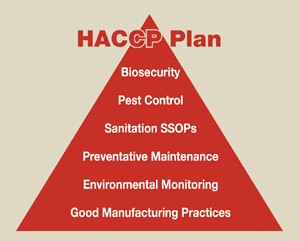If you run a business in the food sector, a food safety program is essential in keeping your business safe for your employees and your consumers. If you don’t know where to start, this it the perfect post for you! This post will be dedicated in providing step-by-step methods you could follow and it will be based on the Hazard analysis and critical control points (HACCP) system.
But first, it’s important for all of us to be on the same page. Some common terms can be interpreted in different ways by different people and in this post the following terms will be used in this manner;
Hazard: a biological, chemical or physical agent in or condition of the food that will cause harm to the consumer
Risk: a combination of the likelihood of a hazard occurring and takes the severity of consequence of the consumer into account.
Basic of a Food Safety Program
Now that we have this term defined, it’s time to start planning. There are really only two main points that need to be followed in order to keep inline with the food safety laws;
- Meet all the food safety requirements set out in the Food Standards Code, specifically in Chapter 3. Important things in thisstep is to ensure that your ingredients come from safe sources and if necessary, be ready to get documentation from the suppliers to prove that the ingredients were prepared in safe conditions.
- Keep a good records! This will help you track where raw materials come from, what condition they arrived in and which product batches they were included in.
This is just the simple overview. For different businesses, you might adopt these two points differently but if you take these two steps into consideration, it will help with your systematic planning for your company. Some tips in developing a more concrete plan is;
- Comply with step 1 first! One you start doing that, it will help you see in what parts there might be flaws in your system.
- In order to develop a HACCP plan, you need to assess the hazards in your business and consider how you are going to control that hazard. That is the most important part in figuring out the safety of your product.
- We suggest the HACCP plan because it is effective. It is very methodical but in some cases, it just doesn’t match with the hazard your business might be facing. In that case, if you can prove that you have put a place control in measure and can demonstrate that has the hazard under control, that is also acceptable.
- In some states in Australia, like Victoria, have allowed the use of templates in this structure. But check with your local government before applying a template to your business.
Who needs a Food Safety Program?
If you are a business owner, you might be thinking to yourself, “Should I consider making a food safety plan?” Of course! This is an essential part to any food related business, but some restaurants are more at risk than others. The top three businesses that should enforce a food safety program are;
- Food services that supply food to a sensitive population eg. nursing homes, school canteens etc.
- Restaurants that serve raw seafood eg. Japanese restaurants that serve sashimi or bistros that sell raw oysters
- Catering companies that supply food to their customers
However, the following other food businesses are also encouraged to place a food safety program;
- Any eating establishments eg. restaurants, cafes and fast food chains
- Manufacturers of fermented meats
- Manufacturers of vegetables in oil
- processed raw foods which are not given pasteurisation treatment eg. sausages, fresh cut vegetables that are to be eaten raw and raw milk cheese.
- Pasteurised food that could be recontaminated during further handling eg. frozen foods
Food is the main concern for a food safety program but there should be other things an employer should consider as they write their program. A very important part of these programs is to protect not only your consumers but to also keep your employees safe from harm. In the food industry, there are two main aspects of workload that needs to be considered – lifting and proper use of a knife.
For lifting, these points should be emphasised to your employees;
- Identify what you are lifting and make a plan!
- Hold the object correctly – check for grease or sharp edges before lifting
- Use the right posture in lifting your object, especially heavy ones
- While walking with your load, keep it close to your body with the heavier side closer to your body
- Unload the same way you lifted it and keep it in a safe place
When using a knife, employers and employees should consider;
- Focus on what you are cutting
- Learn to control your knife properly
- Always use a sharp knife
- Use a chopping board
- Gather all your ingredients in one place
- Do not attempt to catch a falling knife
- Keep your knife clean so there will no chance of cross-contamination
- Wash knife separate from other items used
If you are still uncertain about how to start up your food safety program, you can always;
- Attend a HACCP training course
- Consult a food safety expert – they are always available!
- Give a call or send an email to Food Safety Australia New Zealand (FSANZ) – they’re always more than happy to help
- Continue researching on the web
